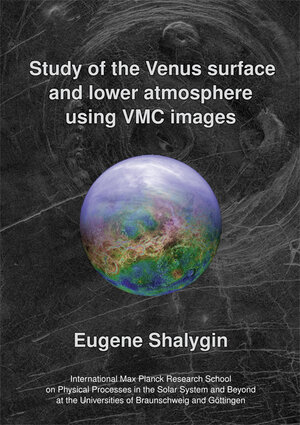
×
![Buchcover ISBN 9783942171717]()
Study of the Venus surface and lower atmosphere using VMC images
von Eugene ShalyginRemote sensing is the only possibility to study Venus surface globally in foreseeable future and is complicated task due to Venus thick atmosphere and clouds. Together they block radiation from surface almost in whole electromagnetic spectrum except radio- and microwaves (where the atmosphere is completely transparent), and a few narrow transparency “windows” in near infra-red (NIR). These transparency “windows” give a unique opportunity to sense Venus’ surface: the surface is hot enough (ca. 470 °C) to produce significant thermal flux in NIR, and this flux can escape to the space and then can be detected at the night side of the planet.
Images obtained by the Venus Monitoring Camera (VMC) onboard Venus Express in 1-μm transparency “window” have been used to retrieve emissivity of the surface. Probabilities of difference in mineralogical compositions of several surface units have been obtained, and gaseous absorption value in low atmosphere has been retrieved.
Since VMC has observed significant part of the Northern hemisphere of Venus, these data can be used to search for hot spots at the surface, which might mean presence of a hot (fresh) lava and ongoing volcanic activity. Therefore possibilities of detecting the lava fields of various sizes and shapes by VMC observations have been estimated.
Images obtained by the Venus Monitoring Camera (VMC) onboard Venus Express in 1-μm transparency “window” have been used to retrieve emissivity of the surface. Probabilities of difference in mineralogical compositions of several surface units have been obtained, and gaseous absorption value in low atmosphere has been retrieved.
Since VMC has observed significant part of the Northern hemisphere of Venus, these data can be used to search for hot spots at the surface, which might mean presence of a hot (fresh) lava and ongoing volcanic activity. Therefore possibilities of detecting the lava fields of various sizes and shapes by VMC observations have been estimated.


